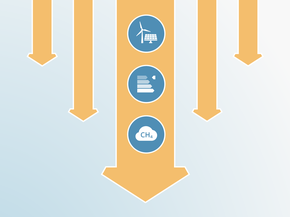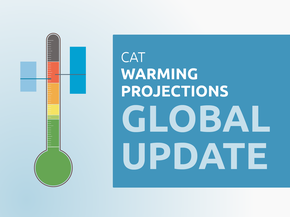Assumptions
Historical emissions
Historical emissions for the period 1990-2023 are from PRIMAPhist dataset (for energy, industry, agriculture and waste) (Gütschow et al. 2024).
Energy related CO2 emissions for 2024 are calculated using CO2 emissions growth rate data from the Energy Institute Statistical Review of World Energy 2025 (Energy Institute 2025). Industrial emissions for 2024 have been estimated using GDP growth rate. We used the 5-year trend (2017-2021) to estimate emissions for the agriculture, waste and other sectors.
LULUCF data is taken from the third Biennial Update Report (Government of Viet Nam 2021). These estimates are calculated using Global Warming Potential (GWP) values from the IPCC’s Fifth Assessment Report (AR5).
NDC target
BAU
The BAU emissions are from Viet Nam’s 2022 updated NDC (Viet Nam Government, 2022a). The BAU scenario for GHG emissions assumes “medium economic development” and corresponding energy demand. The pledge emissions have economy wide coverage. The BAU starts from 2014 inventory data, with projections for 2020, 2025 and 2030. In the NDC, BAU emissions are reported using the AR4 GWP, we converted these to AR5 by applying the five-year average AR4-to-AR5 conversion ratio for each sector, using data from 2016–2020 (i.e., the year of the first reporting year, 2020).
NDC
The 2022 updated NDC provides a breakdown of sectoral emissions reduction in GWP AR4 in 2030. We sum up the reduction amount from energy, agriculture, waste and industry in 2030 and subtracted these from BAU emissions in 2030 to derive the NDC targets.
The CAT methodology for rating NDCs is based on GHG emissions from fossil fuels. We exclude the LULUCF sector from our calculations. For more information, please refer to the CAT methodology section.
Current policy projections
Power CO2 emissions
The emission estimates from the updated 8th Power Development Plan (PDP8) from May 2025 with power sector emissions targets (197-199 MtCO2e in 2030). The yearly emissions are interpolated to 2030 from historical emissions from 2024 (Ember 2025).
For post-2030, sectoral current policy projections were interpolated with the 2050 power sector emissions range included in the updated PDP8. The upper bound of the current policies power sector emissions projections coincides with the upper bound of the range indicated in the PDP8. The lower bound of the current policy projections was calculated using the average of the growth rate of power sector emissions from both ends of the range included in the PDP8 (Viet Nam Government, 2023a).
Non-power energy CO2 emissions
Non-power energy CO2 emissions are assumed to follow the same growth rate as in the APEC Energy Demand & Supply Outlook 2022 (APEC, 2022). The current policy projections take into account the energy savings from the Viet Nam National Energy Efficiency Program 3, but do not include the World Bank funded Viet Nam Scaling Up Energy Efficiency Project which would further reduce energy demand (APEC, 2022).
Non-CO2 emissions
We use the non-CO2 emissions projection growth rates for agriculture and waste sector and harmonise these to the latest historical year of 2024 (U.S. Environmental Protection Agency, 2019).
For the lower end of industrial process emissions, we assume that the last historical year (2024) growth rate will continue, and for the upper end we take the GDP growth rate on which the 2025 PDP8 is bases, 10% per year.
Net-zero target
Viet Nam's National Climate Change Strategy (NCCS) establishes emission limits for each sector by the year 2050: the energy sector is set at 101 MtCO2e, agriculture at 56 MtCO2e, industrial processes at 20 MtCO2e, and waste at 8 MtCO2e. These sectors collectively will amount to 185 MtCO2e of residual emissions by 2050. Additionally, the Government of Viet Nam assumes negative emissions from the LULUCF sector of 185 MtCO2e by 2050, resulting in a net zero emissions outcome by 2050. For this reason, we assume 185 MtCO2e of residual emissions remaining in Viet Nam’s net-zero target year of 2050.
However, the NCCS does not explicitly mention the global warming potential (GWP) utilized for estimating emissions. According to the NCCS, the percentage reduction targets from BAU emissions for each sector, aiming for net zero by 2050, are as follows: energy sector 91.6%, agriculture 63.1%, industrial processes 84.8%, waste 90.7%, and LULUCF at 90%. We have validated these percentage reduction figures against BAU emissions in GWP AR4, as indicated in the Nationally Determined Contributions (NDC) of 2022 (Viet Nam Government, 2022a). Therefore, we converted the GWP by applying the five-year average AR4-to-AR5 conversion ratio for each sector, using data from 2016–2020.
Global Warming Potentials
The CAT uses Global Warming Potential (GWP) values from the IPCC's Fifth Assessment Report (AR5) for all its figures and time series, unless otherwise stated. Assessments completed prior to June 2025 used GWP values from the Fourth Assessment Reports (AR4), and those completed prior to December 2018 (COP24) used GWP values from the Second Assessment Report (SAR).
Further analysis
Latest publications
Stay informed
Subscribe to our newsletter




